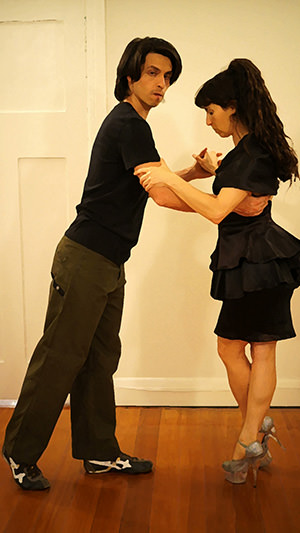Disambiguation
Cross-system is deprecated in favor of trot-system.
Some people use the term ‘front cross’ to refer to a front ocho or other situations where a front step presents crossed legs to the partner (and likewise ‘back cross’). To avoid confusion, we use ocho and describe crossed steps without pivot according to gait and track. We reserve ‘cross’ to refer to diagonal projections.
Definition
Crosses are diagonal redirections of the revel’s second projection. They can be done at the end of any step (front, back, and side step), crossing her free leg either in front of or behind her base leg.
- If you are missing crosses (perceiving them, but too late), it’s because your second projection is missing.
- To improve your mark, decelerate the step (even make a parada with weight split between your feet), then use your arc to guide her second projection diagonally to the place you want.
In most crosses, there should be no pivot. Both mark and revel should keep hips in the orientation of the previous step. Mixing a cross with an ocho is uncomfortable and unsightly. (Exception: ocho-cortado, a special cross.)
Front cross: Revel’s free leg crosses in front of her base leg
From pace-system or trot-system, walking front or back, the Mark pauses mid-transfer, with his back leg’s knee fully extended and its ankle flexed (heel on the floor).
From this position, he can redirect the Revel’s second projection simply by extending his back leg’s ankle to guide the arc (and her free leg’s psoas muscle) about 4cm left or right. (Actually he can use this same system to mark either a cross or a parallel change of foot at the end of the step.)
The mark is not lateral. A lateral mark will cause the Revel to pivot, as will any change of embrace. As in any movement in which the partners move in the same direction, there must be no change in elbow flexion or shoulder-flexion.


- The Revel will not change her weight onto the crossed foot until you direct the arc all the way to the correct position to make the crossed foot the new base leg. (This gives the possibility to make a crossed projection without a change of foot.)
- Ensure that your free leg’s toes cross behind the position of your base leg’s toes. As you arrive to the cross, flex your free leg’s knee and keep its ankle extended, so that only your free leg’s toes are touching the floor. (How to change feet is coming below.)

The most common front cross is marked to the revel’s left leg, but the other side is available too.

Back cross: Revel’s free leg crosses behind her base leg
A diagonal projection can also be used to cross the revel’s free leg behind her standing leg.
From pace-system or trot-system, walking front or back, the Mark should pause mid-transfer with his back leg’s knee fully extended and ankle also extended (the ball of the foot is touching the floor). He can redirect her second projection simply by flexing his back leg’s ankle (putting his heel onto the floor). The motion of his hips will pull his own body body (and her free leg) about 4cm left or right causing him to change feet as she does.

-
- While it’s possible and pretty for the mark to mimic this cross, simply crossing your own feet is not marking, it’s an adorno.
- If you are missing back cross, you are probably skipping your old base leg’s knee and ankle extension during your front step (second projection). Spend more time there, and you’ll give yourself and the mark more time to communicate the back cross.
- The mark is not lateral. A lateral mark will cause the Revel to pivot, as will any change of embrace. As in any movement in which the partners move in the same direction, there must be no change in elbow flexion or shoulder-flexion.
- An easy variation (and trick) for marking back cross is to swing the revel slightly into a lean / colgada. While this is nice, you don’t want to rely on this method (partly because it’s not fast enough for milonga). Learn to do things correctly so you have more control and more options.
- In a back cross, flex your base leg’s hip and knee and lift its heel, without breaking your arc! Use the muscles of your arc to draw the free leg under, rather than throwing the free leg forward.

- The free leg’s toes should arrive in front of the base leg’s toes.
- Back cross is often used as an exit from revel’s front gancho and mark’s front sacada to the revel’s side step. Both mark and revel need to be able to distinguish clearly between back cross and back ocho, two alternate exits. One has pivot, the other doesn’t!
Crosses from sidestep
The most common cross from sidestep is known as ocho-cortado.
A more unusual, but very beautiful cross from sidestep is marked without pivot, through two consecutive projections, first front (or back) and then diagonal into the desired cross. Again, this can be marked by initiating a lean (colgada) and using gravity to swing her free leg about, but that method is not necessary. It takes more skill to do it with projection. So learn it that way first.
Finishing the cross (change of foot)
It’s common to “complete” the cross by changing the revel’s weight onto the crossed foot.
In a front cross she extends the crossed leg’s knee while gradually flexing her ankle, maintaining hip flexion at all times.
In a back cross, the weight is usually shared between the two feet at the end of the diagonal projection. To complete the transfer of weight to the crossed foot, she extends its knee and moves her arc to the new foot.
Cross without change of foot (fake)
When no change of foot is marked at the end of a cross, it is sometimes described as “fake”, which means that the diagonal projection is released without change of foot and the revel is projected toward what would have been the next continuous step prior to the diagonal projection. Fake front crosses are more common than back ones, but both are possible.
- To mark a fake cross don’t move your arc all the way to the top of the new leg. Keep it pointing at the current base leg, then create a new projection.
The next step
The cross is a cramped position for the revel, and as a result the next step is often a mess, ill-timed and uncomfortable. Either the revel rushes (because she falls) or the mark rushes her (breaking the connection), or revels routinely rush because they’ve got bad habits from being rushed too much.
- Both mark and revel need to be attentive to finding the arch of connection on the new foot before moving toward whatever’s next. If the mark fails to do this, he rushes the revel and she must compensate to keep up with his next step.
- If the revel fails to organize her arc of muscles on the new foot, she may take an arbitrary or premature next step, dragging the mark along with her.
- To make the next step connected the first thing is to build the arch anew just as at the end of any other step. Then be sure to mark a projection before starting to transfer into the next step.
- We can and should vary the exit from the cross, in many different directions and into sacadas, voleos, and ganchos.











